
Kaludiya Pokuna (Sinhala: දඹුල්ල කළුදිය පොකුණ) is a site with a ruined Buddhist monastery located near Kumbukkandanwala (Dambulla) in Matale District, Sri Lanka.
History
This has been identified as the ancient Dakkhinagiri Vihara [(Dakinigiri Vehera) Nicholas, 1963]. According to Mahavamsa, Dakkhinagiri Vihara was built by King Saddhatissa [(137-119 B.C.) Nicholas, 1963; Ranawella, 2001]. However, Culavamsa mentions that King Dhatusena (455-473 A.D.) built the monastery named Dakkhinagiri Vihara (Nicholas, 1963; Ranawella, 2001). It is believed that Dhatusena had only affected certain repairs during his reign to the Dakkhinagiri temple which had been built by Saddhatissa (Ranawella, 2001). King Aggabodhi I (571-604 A.D.) is said to have constructed a Uposathaghara (a chapter house) at Dakkinagiridalha Vihara which is probably the same temple (Nicholas, 1963). King Kassapa V (914-923 A.D.) granted a village to this monastery (Nicholas, 1963).The identity of this place as Dakkhinagiri Vihara was confirmed by two inscriptions discovered from the site (Nicholas, 1963). These two inscriptions belong to the reigns of King Kassapa IV (909-914 A.D.) and King Sena III (938-946 A.D.) and they record the name of this temple as Dakinigiri Vehera (Ranawella, 2001). The name Dakinigiri Vehera has been found among the graffiti of nearby Sigiriya (Nicholas, 1963).
Inscriptions
Three inscriptions have been discovered from this site (Paranavitana, 1933). The earliest of them which belongs to the 7th century A.D. has been engraved on a plain guard stone of the flight of steps at the southern entrance to the courtyard of the Stupa (Paranavitana, 1933). The other two inscriptions belong to the 10th century A.D. and have been dated by scholars to the reigns of King Kassapa IV (909-914 A.D.) and King Sena III [(938-946 A.D.) Ranawella, 2001; Ranawella, 2004].
Kaludiyapokuna cave inscription of Kassapa IV (909-914 A.D.)
Period: 10th century A.D. Script: Medieval Sinhala Language: Medieval Sinhala
Content:
The inscription is dated in the 12th regnal year of the king. It registers certain donations (23 Kalandas of gold) made by eight persons for providing Laha-bat (ticket-meals) to the inmates of the Dakinigiri monastery.
Notes: Paranavitana had identified the king of this inscription as Sena II (853-887 A.D.). Ranawella corrected his reading later and identified the king as Kassapa IV.
Reference: Raranavitana, 1933; Ranawella, 2001. Kaludiyapokuna slab inscription of Sena III (938-946 A.D.)
Period: 10th century A.D. Script: Medieval Sinhala Language: Medieval Sinhala
Content: The inscription is dated in the 1st regnal year of the king. It contains a set of rules and regulations to be adhered by the monks of Dakinigiri-radmahavehera as well as by officials and workers who have been assigned to the temple duties. It also mentions that any person who breaks these rules and regulations will not have the fortune to see the Bodhisattva Maithri.
Reference: Ranawella, 2004.The site
The site which has been declared an archaeological reserve extends into an area of about 40 acres (Abeyawardana, 2004). It comprises a large number of ruins including rock caves, a Stupa, inscriptions, residential cells and other ancient remains (Abeyawardana, 2004). These ruins belong to the period 5th to 10th century A.D. (Abeyawardana, 2004).The ancient monastery at Kaludiya Pokuna is said to have been built according to the Pancavasa tradition (Abeyawardana, 2004). The brick-built Stupa has been built on an elevated platform. It is believed that this monastery had been used by the monks of the Dhammaruci sect (Abeyawardana, 2004).
Kaludiya Pokuna means the "Blackwater pond". The water of the pond that
is found in this site has become dark colour due to natural causes of the surrounding environment.
Attribution
References
1) Abeyawardana, H.A.P., 2004. Heritage of Kandurata: Major natural,
cultural and historic sites. Colombo: The Central Bank of Sri Lanka.
pp.180-181.
2) Nicholas, C. W., 1963. Historical topography of ancient and medieval
Ceylon. Journal of the Ceylon Branch of the Royal Asiatic Society, New
Series (Vol VI). Special Number: Colombo. Royal Asiatic Society (Ceylon
Branch). p.111.
3) Paranavitana, S., 1933. (Edited and translated by Wikramasinghe, D.M.D.Z.; Codrington, H.W.) Kaludiyapokuna inscriptions.
Epigraphia Zeylanica: Being lithic and other inscriptions of Ceylon
: Vol. III. Printed at the Department of Government Printing, Sri Lanka
(Ceylon) for the Archeological Department. pp.253-269.
4) Ranawella, S., 2001. Inscription of Ceylon. Volume V, Part I. Department of Archaeology. ISBN: 955-9159-21-6. pp.251-254.
5) Ranawella, G.S., 2004. Inscription of Ceylon: Containing pillar inscriptions and slab inscriptions from 924 AD to 1017. Volume V, Part
II. Department of Archaeology. pp.143-146.
Location Map
This page was last updated on 14 November 2022

